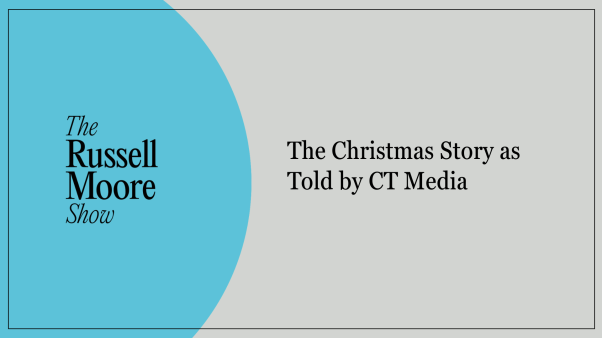One day in the middle of the pandemic, I was working a typical pastoral day patching some drywall at our Orlando, Florida, church building, when a church member dropped by to catch up. The week before, we’d had a conversation about joy. I had asked him, “What is stealing your joy right now?” He thought long and hard about that question and wanted to follow up.
“Hey, Mike, your question about joy the other day was really hard, but I had an epiphany,” he said. “I realized that having Fox News on 24/7 at home was the number one thing stealing my joy and making me angry. So this week I decided to turn it off, and it has really made a difference.”
I told him that I was proud of him for his honesty and for taking a significant action step to safeguard his joy in Christ. But then he added, “Except for Tucker Carlson. I watch him every night.”
I’ve heard similar stories from the other side of the political aisle. Our current reality is no different from this story. What are pastors to do when their church members consume narratives throughout the week tenfold more than their Sunday sermons? What do we do when members who helped found our churches now threaten to leave due to these narratives? What do we do when evangelicalism feels irrevocably fractured?
The evangelical movement has long been a tapestry of diverse convictions and traditions, united by shared doctrinal and cultural factors rather than formal structures. The term evangelical implies an overarching unity that allows and accounts for diversity without imposing uniformity. This both gives the movement its force and makes it hard to discern its exact contours.
Today, that visage has grown even less clear. Four years ago, we observed in an essay for Mere Orthodoxy that evangelicalism had fractured. The response to American political events that drove media attention and cultural conversation revealed an underlying rending of the evangelical fabric.
As we saw it, the fracturing of evangelicalism revealed that the historic bonds holding the movement together were less intellectual than they appeared but were rather socioeconomic, political, and cultural. Dividing lines lurked beneath the surface for some time, but in the wake of a series of flash points, the comfortable order of allegiances was disrupted, fractured by unspoken yet deeply held commitments. We categorized the splintering into what we saw as six groups (and added one more borrowing from Mere Orthodoxy editor in chief Jake Meador’s observations):
0 – Right-Leaning Exvangelicals have left the church but identify as Christian or promote the merit of Christianity for the preservation of conservative cultural values and institutions.
1 – Neo-Fundamentalists focus on biblical fidelity and conservative values. This group is deeply concerned about liberalism and growing cultural hostility toward Christianity.
2 – Mainstream Evangelicals prioritize the Great Commission, so while they are concerned by extreme fundamentalism, they are more worried about the secular left’s influence.
3 – Neo-Evangelicals emphasize the global nature of the movement and the need to engage with the culture. This group critiques conservative political allegiances and failures on social issues while addressing liberal Christianity’s theological compromises.
4 – Post-Evangelicals center on justice and accountability. They challenge hypocrisy and abuses in the church while distancing themselves from evangelical identity, though they hold to core doctrinal beliefs.
5 – Left-Leaning Exvangelicals have dechurched due to disenfranchisement with evangelicalism’s failures but retain some orthodox Christian beliefs.
6 – Dechurched have left both the church and Christian faith entirely, abandoning all vestiges of belief.
Four years ago, we predicted a number of possible scenarios and futures for evangelicalism in the wake of such a fracturing. Most importantly, we recognized that the fracturing was likely irrevocable. This has proven to be true; we are no longer in the era of fracturing. We have transitioned into a new era within a fractured evangelicalism.
But this need not lead to discouragement or despair; rather, the fractures of evangelicalism have given way to a certain clarity that allows Christian churches to reconceive and renew their commitment to the gospel. A fractured evangelicalism is not a terminal diagnosis. This is not the movement’s first fracturing, and as historical precedent shows, such a moment can give way to new faithfulness for individuals, movements, and institutions that fall under the “evangelical” label. There is a way forward for the movement that remains committed to evangelical distinctives and the spread of the gospel internally and externally, locally and globally.
Through the early years of the fracturing (circa 2014–2019), the average American evangelical church might have been largely populated by people with differing cultural sensitivities. A church might see a combination of groups 1–4 sharing a pew in worship, serving in the children’s ministry, and communing in small groups. In fact, proximity is what gave rise to the seemingly ever-present tension of those years.
But as the cultural waves crashed over these communities and receded, they exposed that, often, the individuals gathered in these churches had many things in common—such as core theological beliefs, preferences in preaching and worship styles, aesthetics, and more—but related to the cultural climate in radically different ways.
Plus, social media offered us more of people’s live, unfiltered reactions to events. A Facebook post by a neo-evangelical small group leader could leave the neo-fundamentalist evangelical church member stunned at the former’s opinion of presidential politics. A post-evangelical might feel that their pastor, who is a mainstream evangelical, is not engaging culture or calling for societal change in a way that is sensitive or helpful.
These dynamics initially led to the fractured groupings, but over time a new reality formed. People began to reconsider their ecclesial affiliation based on these cultural factors. No longer could a neo-fundamentalist sit comfortably with a neo-evangelical. Nor could a post-evangelical serve next to a mainstream evangelical. Suspicion, anxiety, and frustration sent people scattering for new group solidarity and prompted movement into like-minded churches. The power of wedge issues created enough tension to ensure that some evangelicals could no longer attend the same church as each other. This was largely solidified by two factors: positions (doctrine) and posture.
Two evangelical Christians might agree on the sanctity of life, the biblical sexual ethic, and the sinfulness of racism. Likewise, these two evangelicals might have voted similarly in previous presidential elections. However, as the social media age matured, these two Christians began to diverge in their responses. The one person might carry an abrasive, “truth-telling” posture in face-to-face conversations and digital interactions. The other might attempt to carry a nuanced, “winsome” posture.
These two people hold identical positions but have differing postures. Positions are the fundamental ideas that we hold. Posture is the affect with which we hold those positions. How one arrives at belief will determine how one embodies the belief. Thus, though theological differences may prevail in a church, the sorting between churches occurred as differing paths to beliefs led to different postures. The net effect is a significant impact on overall comfort in a church and a space.
As the fracturing settled, it became obvious that new solidarities were not based strictly on ideological grounds. In part, this is because the way that we arrive at a doctrinal position often determines solidarity more than the position itself. Humans are not hermetically sealed brains that arrive at propositions through pure, brute-force reading of the Bible. Cultural, emotional, behavioral, psychological, relational, and experiential factors often pave the way to our doctrinal destinations. Even those in denominations with antiseptic doctrinal statements have struggled to find solidarity in a fractured evangelicalism because they came to their convictions through different pathways.
The explosion of social media, videos, and podcasts serves as one of the most powerful factors in doctrinal and cultural discipleship and significantly shapes how individuals come to positions.
But our newfound solidarity within these church types is driven by shared posture rather than shared positions. If you were to move to a new city and visit all the churches in town, you might find the ways they self-describe and self-identify loaded with all sorts of subtleties that communicate what types of churches they are. The term Baptist, Presbyterian, or Methodist would no longer be the defining difference between a church and its neighbor church down the street. Instead of denominational labels, you may be looking for the ways they discuss politics—and their political enemies.
The question “What voices do you most trust in evangelicalism today?” once might have turned up a wide array of answers in any given church. This is less likely now and reveals a more settled fracturing. Position matters, but posture is how you find your tribe.
Today, it is more likely people have found themselves in spaces with compatible postures, prioritizing these over doctrinal compatibility. Many Christians in everyday experience choose a church based on “vibes.” Gone are solidarities forged in the debates over the charismatic movement, worship wars, and the emergent church. One need only look at Southern Baptist presidential politics to see men who once questioned others’ Baptist credentials over Calvinism today nominating those same people for leadership positions. It is common, too, for non-Christians to speak at Christian conferences if they share the same posture on specific issues. This is part of the new world of settled fracturing within evangelicalism.
So what is the personality of evangelicalism today? We see three main characteristics that define today’s fractured evangelicalism: church centers, new movements, and the gender divide.
Mid-20th-century missiologist Paul Hiebert borrowed terms from set theory in mathematics—bounded set and center set—to describe ways of thinking. According to Hiebert, bounded sets have essential characteristics, have clear boundaries, are uniform in essential characteristics, and are static. Center sets have a defined center, and people judge things by the distance from their location to that center.
Some have created a metaphor for this of two livestock ranchers. The bounded-set rancher builds a fence to keep sheep within the field so they don’t stray. The center-set rancher builds a well, knowing the sheep won’t stray far from their source of nourishment. Churches today often define their centers and boundaries through primary theological commitments, secondary theological commitments, and cultural matters.
We see three new types of churches emerging from the fracturing, all of whom define their boundaries differently.
The first type is a combination of neo-fundamentalists and mainstream evangelicals. These churches see the culture as the problem facing the church and posture themselves in opposition to it while promoting a vision of a renewed Christian society. They tend to place fence posts around primary theology, secondary theology, and cultural matters. While a positive vision of biblical faithfulness is usually at the center, these churches often define their identity by who is in and who is out. Gospel proclamation is the hope of moving people from without to within while condemning churches and individuals who are squarely outside their boundaries.
Another group of churches, a combination of mainstream evangelicals and neo-evangelicals, is more likely to see the world’s fallenness inside and outside the church as the problem and to see themselves as salt and light in the world. They tend to be bounded set on primary theological commitments and a mixture of bounded and center set on secondary and cultural issues.
While there is certainly an idea of orthodoxy that defines the boundary, their pursuit of the center rises higher, often within discussions of the Great Commission and the kingdom of God.
Finally, churches composed of a combination of neo-evangelicals and post-evangelicals see Christian hypocrisy and sin inside the church as the most pressing issue. They tend to be center set on primary and secondary theology but draw firm boundaries on cultural matters. Only those who agree with a certain ethical vision in the modern world are within the boundary to pursue that vision with them.
No church is boundaryless or purely center-driven. Furthermore, postures are often the unstated embodiment of a church’s boundaries and centers and are extremely revealing. Ironically, the first and third groups of churches often end up being like photo negatives of each other on issues such as gender, sexuality, politics, and race. As cultural flash points occur, boundaries intensify and can lead to flared tempers and anxiety.
 Art by Derek Brahney
Art by Derek BrahneyThe middle group of churches does not minimize cultural issues, but due to its center focus, the heat in these moments is turned down. The focal point rises higher in terms of importance. Nevertheless, these churches and peoples are not separated from the world and will often feel the intense tug of war on any given issue pulling toward the churches on their left and right.
In the past two years, the defining cultural values for evangelicals have cooled due to a larger shared agreement around the tragic events in Israel on October 7, 2023; flash points around gender; and renewed cultural conversations around the benefits of Christianity for self and society. Still, these boundaries and centers exist and will fluctuate.
Much of the fracturing we’ve beheld itself derives from a mistrust of the institutions that have defined the shared life of evangelicalism. Our publications, seminaries, denominations, pastors, and churches that once were viewed as the banners of the movement are now under suspicion. The net effect leaves institutions still standing but not necessarily thriving. In a setting of such chaos, two notable movements have arisen that are not obviously associated but do derive from this context.
The first movement might be called New Pietism, the school of thought commonly known as “Rule of Life” or “Comerism,” after the popular writer and pastor John Mark Comer. This movement emphasizes the cultivation of one’s spiritual life, with a heavy focus on spiritual practices that inspire the individual to holistic commitment to Jesus Christ.
While there are many factors in this movement’s explosion in the past decade, it is notable that its mainstream attention grew most significantly as the fracturing settled. It might be said that New Pietism arose out of a desire to leave behind the chaos and clamor that defined the fracturing period. As with its spiritual predecessor in the 17th century that reacted against institutional failure in its time, the emphasis of New Pietism largely rests on the individual, though it is not in opposition to communal cultivation of piety. With historically reliable institutions under suspicion, the turn inward serves as a great call to take account for oneself.
This movement will likely transcend the fracturing through an otherworldly pursuit. Its development doctrinally and communally will define its contours.
The second movement is what we call New Transformationalism. If New Pietism is the extreme inward, individual response to the fracturing, hoping to rise above it, New Transformationalism is the extreme outward, communal response. This movement desires to engage culture and society in the hopes of bringing them into alignment with Christian principles. It is incumbent on the Christian community, then, to take up the task of cultural transformation.
Christian nationalism is the form of this movement that has dominated the popular conversation on both sides of the spectrum. But opposite it, other groups want to see American society and the church reckon with failures to uphold biblical justice. Both turn outward to the world in hopes of Christian renewal.
The New Transformationalists differ from those who emphasize cultural renewal, because they believe the institutions that have structured American society and evangelicalism are complicit in the miscarriage of justice—the specifics depending on how one defines that. These institutions must be dismantled finally and totally, in their view, so that new institutions may arise to resurrect the movement upon a better foundation. This is the calling of the Christian community in today’s age. Those who bear the name “Christian” and do not join in this vision are complicit with these failed institutions.
Both New Pietism and New Transformationalism look at the turbulence of fracturing and long to move forward in faithfulness. The former seeks faithfulness internally and individually. The latter seeks faithfulness externally through the community.
But as the fracturing settles and institutions remain weary, we can expect these movements to grow and appeal to many across the fracturing spectrum. We may also expect that many, notably mainstream evangelicals, will feel threated by these movements that they see as distractions to the Great Commission.

Perhaps the most culturally significant reaction during the period of the fracturing is the gender divide. Large numbers of women are moving out of the church, and men are moving in (or at least are leaving at slower rates). In 2008, 34 percent of college-graduated men and 36 percent of college-graduated women in the US attended church at least once a week. By 2023, men had dropped off by 2 percent (down to 32%) and women by 9 percent (down to 27%). The results are similar over the same time period for those who have only some college education.
Notably, for the first time since religious data has been recorded, there are now more younger men than younger women in church. And there are now more women over the age of 32 who never attend church versus their male counterparts. In my (Michael’s) book, The Great Dechurching, I found that 65 percent of dechurched exvangelicals are women. Men and women are entering this new era of evangelicalism in very different ways.
It is perhaps too early to answer why the fracturing has been received in such vastly different ways by men and women from otherwise similar racial, socioeconomic, and geographic backgrounds. While there are many possible reasons, we see social media, Western civilization, and the last three election cycles as major influences.
With the atomization of media, men and women are often not listening to the same voices and perspectives. This does not necessarily mean that women are more likely to engage with personas pushing them out of the church, but it does in part explain the radical divergence in cultural attitudes and engagement.
Some have also had concerns over the health and well-being of Western civilization. From newly converted Christians (such as Ayaan Hirsi Ali) to avowed atheists (such as Richard Dawkins), there seems to be a large, influential sect of cultural conversation promoting Christianity as foundational to a thriving society. But this conversation tends to code more male than female, such as apologist Wesley Huff’s appearance on Joe Rogan’s podcast, a show with an overwhelmingly male audience.
And of course, men and women have responded to the presidencies of Donald Trump in divergent ways. His popularity since his first campaign has grown, and his strength with evangelical men solidified, while many women are still wary. These varied reactions might offer insight into women’s faster rate of disillusionment with evangelicalism than men’s.
Regardless of the underlying causes, the widening gaps between young men and young women in politics, religious belief, and religious attendance will play a significant role in the contours of the fracturing of evangelicalism.
Life within a fractured evangelicalism is still taking shape. But there is a way forward. What should we do? The church needs to prioritize the goodness of the gospel, holistic discipleship, and prayer for institutional revival.
First, given that cultural flash points will continually change but never subside, evangelical churches must commit to firm doctrinal boundaries and champion the center. To use the rancher analogy, churches must draw people to drink from the well of life. Boundaries must be established by upholding the standard of historic, biblical orthodoxy. This is no cold, dead orthodoxy but one that speaks powerfully and compellingly to and in the language of the world today. Firm boundaries should always point to the center.
At that center must be the gospel of our Lord Jesus Christ and the expansive hope it offers for the transformation of all people. Applying and proclaiming the gospel to the world has always been the defining feature of evangelicalism. With this gospel at the center, all cultural and theological matters will relate to it organically and be set in their proper relationship to one another. The evangelical church should never be ashamed of its boundaries but rather should stand on them as the foundations from which we invite the world into the gospel’s glories at our center.
Second, churches can pursue holistic discipleship. Discipleship cannot be thought of as an information transfer from one brain to another, as if only positions matter, but as the shaping of doctrine and postures along paths established by the gospel. Competing allegiances and compelling alternatives continue to strip the church of millions of disillusioned individuals.
For the church to recover its effectiveness in passing on the faith, it must embrace the whole gospel within the whole church for the whole person through discipleship of children, integration of faith and work, cultural apologetics, and more.
Third, we also believe there can and must be institutional revival. Evangelicalism has been blessed by an abundance of resources devoted to and developed by institutions sharing the Great Commission. Embracing the spirit of Nehemiah, we should devote ourselves to building and rebuilding the institutions that have defined the movement.
This call is not in the spirit of a baptized nostalgia saying, “Make evangelicalism great again.” The call is to recognize the unique stewardship of gifts and resources that institutions offer when they serve the local church. The movement needs Christian media, missions organizations, seminaries, and others to coordinate, train, resource, and commission men and women to bring the gospel to their neighbors, coworkers, foreign powers, remote tribes, and the ends of the earth. Coupled with this, the movement needs multidirectional leaders—who embody the fruit of the Spirit rather than grasping for personal glory—guiding these institutions. These will strengthen the church—God’s primary plan for caring for his flock and reaching the lost.
Fourth, churches can solidify a geographical commitment. In the pre-fracturing world, like-minded churches could pull from a wide range of sources to support church planting, ministerial training, mercy ministries, and more. But the past decade of fracturing has doomed many such national and global networks.
Now, many evangelicals have started to recognize the power of geographical commitment from a diverse web of churches within a local area. A friend of ours in rural Texas recently described a theological library, church plants, and pastoral fellowships that have developed across denominational and cultural lines through this sort of commitment. While diverse in theology and posture, they share a passion to see the gospel flourish in one region. As others have noted, large churches are especially equipped to serve this vision if they steward their resources for the benefit of local ministries, organizations, and other churches rather than brand multiplication.
Cultural clashes between Christians will continue in the post-fracturing era—but so will concern for one’s locale. Partnership on this foundation will serve as a steadying force for the movement.
In many ways, all that we have described here is the application of “evangelical catholicity.” It is an idea, first raised by Kevin Vanhoozer, that the evangelical movement and its individual churches are united to the whole church of Jesus Christ across space and time and embrace all human life and experience. The subsequent ethic entails constructive service through a united and diverse church.
A fractured evangelicalism is not a wholly negative proposition. As we have seen, some of the churches that experienced the most painful ruptures have also experienced the most hopeful reforms in their wake. The fracturing and sorting was a period of pain, but from the pain came new life.
The church where we both worked in Orlando felt like a constant war zone for the better part of a decade. Today it feels vibrant, exploding with zeal and love for one another and the mission. Our renewed life arose not from some new program or method devised to rehabilitate a past vigor. Rather, it was built slowly as our church committed itself to allowing God’s Word to shape us holistically in our lives and our relationship to the city, institutions, and other churches.
This is not only our story but also the story of many churches that, in the wake of a visceral fracturing, returned to the life-giving power of God’s Word. Pastors who previously felt isolated and under siege are now passionately connecting with others in their areas to seek the good of their given cities. This is evangelical catholicity flowering out of the fracture in the lives of churches.
For the evangelical movement to remain a movement motivated by the spread of the gospel and the glory of God, it must embrace an evangelical catholicity. We must center the gospel and hold to orthodoxy, equip the saints for pious living and societal engagement, build institutions, and invest locally with new and surprising partners. If we embrace this life, the church will be prepared to enter faithfully into an unpredictable future, a rapidly changing world, and the fracturing that defines our present.
Skyler R. Flowers is an associate pastor at Grace Bible Church in Oxford, Mississippi, and associate program director at The Keller Center.
Michael Graham is coauthor of The Great Dechurching and program director at The Keller Center.

















